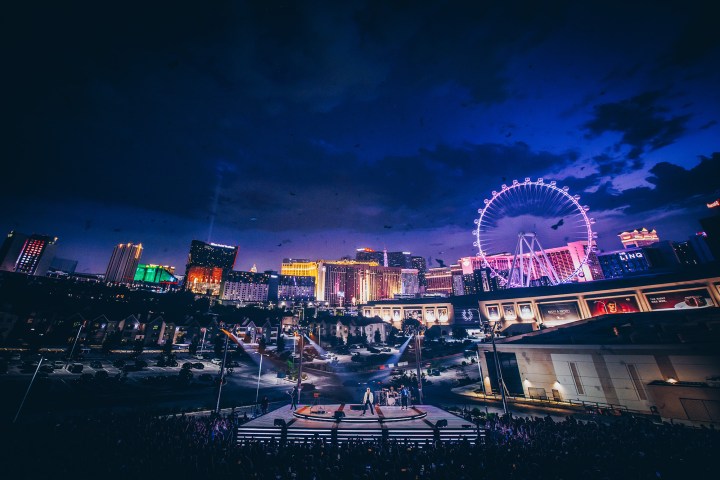
I recall sitting in the back of a Las Vegas taxi in January 2022. CES was upon us. While Las Vegas is extra on a typical Tuesday, CES week ramps things up to a totally different level. The pandemic meant a couple of years without having to do the CES thing, and Vegas reinvents itself in the blink of an eye.
That still didn’t explain the giant black orb that seemed to pop out of nowhere on Sands Avenue.
“What the hell is that?” I muttered in the back of that cab. I’d soon learn that it was a new event space and was going to be covered with LEDs, inside and out. At the time, though, the opening was 18 months away, and all it seemed to be was a big, black sphere.
We know differently now, of course. The Sphere opened in late September 2023, with Irish rock band U2 having set up shop with some three dozen shows for “U2:UV Achtung Baby Live at Sphere” scheduled through mid-February 2024. Thousands and thousands of fortunate fans have already experienced the spectacle. Millions more of us have gotten glimpses through cell phone video and online videos. And while that certainly doesn’t do it justice, even that tiny, two-dimensional peek inside makes it pretty clear Sphere hosts the sort of futuristic live experience that simply hasn’t been done before. (And none of this includes what you might see on the outside of Sphere.)
So we have some idea of the magic that goes on inside, during the show. We wanted to get a glimpse of what powers it all. What makes that magic happen.

“There’s nothing that we couldn’t do in terms of, you know, if we have an idea, we could certainly make it happen,” Brandon Kraemer tells me. He served as a technical director with Treatment Studio, a London-based creative agency that has worked with U2 for years. Kraemer says that line casually, as if creating mind-bending visuals behind one of the world’s biggest bands is an everyday experience for Treatment. But the fact is that U2 and Treatment have been at this for a while. Even before Sphere opened, U2 shows have been known for their visuals — The Joshua Tree 30th anniversary tour and Experience + Innocence tour, to name two in recent memory — and Treatment Studio (founded by Willie Williams and Sam Pattison) was a driving force behind that.
“There’s nothing we couldn’t do. If we had an idea, we could certainly make it happen.”
But in an industry — and in a city like Las Vegas — in which huge visual spectacles are table stakes, even a venue like Sphere was going to have to do something different. Bigger and brighter. Once Sphere is filled with more than 18,000 fans, and a band, and the internal surfaces are lit up with 160,000 square feet of LEDs at 16K resolution for 256 million individual pixels — yes, you read that right — then toss in the fact that you’re doing all this in the shape of a sphere? There’s no way it wasn’t going to be incredible.
And it turns out that shape isn’t actually the hardest part.

“The daunting aspect of this isn’t the fact that it’s, you know, spherical,” Kraemer says. “It’s the fact that the resolution is 16K by 16K. … We actually broke several pieces of software along the way. We certainly reached limits of what most computing power can do, and most software that we usually designed with can do.”
That’s a lot of pixels to push. And pushing them is Disguise — another big name in this space that powers the shows for many of the world’s best. To oversimplify things more than a bit, if Treatment is on the creative side of the equation, Disguise plays a giant part in the hardware and software platforms. This isn’t quite off-the-shelf stuff, either. (Though Disguise has a web-based, 3-dimensional pre-visualization platform that’s pretty fascinating to see in action.) We’re talking major servers and hard drives for the ridiculous amount of data that goes into a Sphere show.
Peter Kirkup, Solutions and Innovation Director at Disguise, says of the Disguise hardware being used for the U2 show: “They have upgraded hard drives in the machine. So we’ve got 30 terabytes of storage on every single machine inside our system there. But we’re also interfacing with a bespoke system, which is in the house, which is driving the LED pixels.”
That’s not just 30 terabytes on a single server, mind you. There are 23 of those things (GX 3 servers, if you must know) at work, for 690 terabytes of storage. Some of that is for the live graphics behind (and above and around) the band. Some are for redundancy and other production power.
Treatment’s Kraemer is quick to say that “the Disguise hardware has been amazing.”
Twenty-three specialized servers with a total of 690 terabytes of storage power the visuals for U2 inside the Sphere.
“We have a lot of experience working with Disguise servers,” he says. “We know what they’re capable of, we’ve used them on every U2 tour that I can think of. In fact, every show that I’ve worked on in this industry, I’ve worked on with Disguise servers. They had the capabilities of what we wanted to be able to do in terms of integrating image magnification into content in a very seamless way.”
You don’t have to have actually experienced a U2 show at Sphere (or any other U2 show, for that matter — the band’s relationship with Disguise goes back nearly two decades) to understand that seamless immersion is the name of the game. That’s apparent even in the countless TikToks that do their best to share what it’s like to be there.

“The fantastic thing about the Sphere is it’s a shared experience,” Kirkup says. “So you’ve got 18,000 other people also feeling that, and there’s that collective response of the audience in there, which, largely, I don’t think audiences have felt yet. This is a new thing. This is a new way of building shows and a new way of creating that emotion.”
Even cell phone videos seem to convey that “new way” Kirkup and Kraemer talk about. It looks like sort of a real-life, high-resolution VR adventure. Which is, of course, the point. The band. The audience. The experience. The emotion. The immersion. Even watching it through your phone — as shot by someone else’s phone — it translates. Certainly not on the same scale, but you get it.
“We’ve noticed that, too,” Kraemer says. “Because there’s a lot of obviously social media coverage of this now. You can see a lot of what we’re doing from different points in the room. You do get a sense of what it’s actually like. It’s not the same as being there, but that’s unique because the screen is not rectilinear. It is spherical, and it’s curved.”
While Kraemer did say that the spherical nature of the visuals didn’t hamper the creative process, it doesn’t mean some guardrails weren’t put in place. If you’ve ever gotten a little woozy with a VR headset, you’d have to imagine how that could happen inside the Sphere with this sort of show. So while Kraemer says there weren’t really any limitations as to what could be done, from a creative standpoint, there were some practical considerations to be had.
“There was one piece in particular,” Kraemer says, “where we did actually adjusted scale so that it appeared to move not quite as fast or over a less large distance, which then translates into speed because it was borderline making us all sick.”
Understandable, even if that is a little rock ’n’ roll. It’s also unique to the venue, Kirkup says.

“Bono actually talked about that,” Kirkup says. “In the opening night when he was on stage talking about how this is the first time really, performers have had a venue designed for performance. If you think of a normal arena or a touring show, they’re going into ice hockey arenas are going into football stadiums, they’re they’re sort of playing second fiddle to the sport a lot of the time. Whereas now, it’s the other way around.
“All of this tech is here to surface performance. At the end of the day, it’s those four guys on the stage rocking out.”
“The venue is for the entertainers. And so the way that the show is built, the way that the audience experiences it, the intimacy of the venue — even though it’s physically large — that doesn’t come across in the YouTube videos at all. But when you’re really there, it doesn’t feel like you’re a million miles away from the stage. Yet, you’ve got this full emotion of the content and everything going on around you. And it really is quite a quite a special experience.”
The tech is impressive, no doubt. The visuals are, to put it plainly (and even without having seen them in person) stunning. They’re also meant to be in service of the show. Of the band. Of U2.
“Something not to forget,” Kirkup says, “is all of this tech is here to surface performance, you know. At the end of the day, it’s those four guys on the stage rocking out, which is what everyone has paid to go see. And that’s important. We are just a part of this, part of the equation. We’re making some cool stuff happen.
“But, you know, the band is there to perform, and they come first. That’s how it has to be.”



